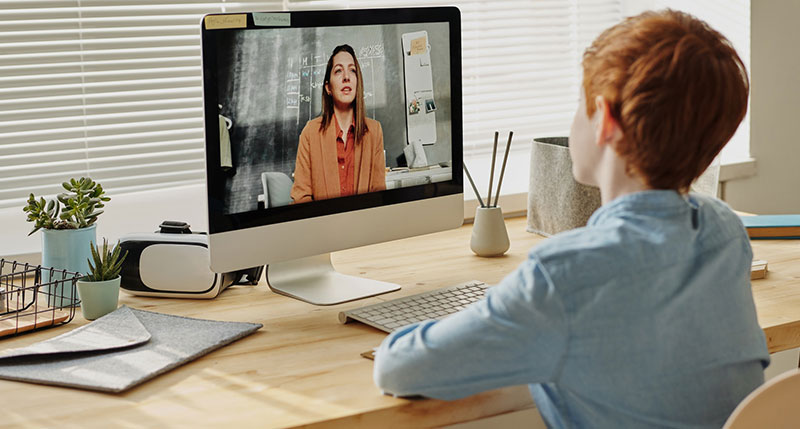It’s back-to-school season! And while everyone hopes that students will be able to attend class in person this year, computers and other digital screens will likely still play a significant role in your student’s education.
Here’s the challenge digital learning presents for our eyes: The human eye wasn’t mean to stare at screens all day long. Staring at a screen for 6 to 8 (or more!) hours per day is like asking your eyes to run a marathon.
And although your student’s eyes are young and vibrant, it’s important to act now to take excellent care of their vision so they can keep seeing their best for decades to come. Good habits learned in youth can last a lifetime!
Beware of Digital Eye Strain, a.k.a. Computer Vision Syndrome
Students and their parents should be aware of the combination of problems known as Digital Eye Strain, and also called Computer Vision Syndrome. It’s the (unfortunate!) result of gazing into a digital screen for hours on end. Since screens aren’t likely to go away, it’s critical to teach your children best practices to help their eyes cope with the ocular challenges of digital learning.
The symptoms of Computer Vision Syndrome/Digital Eye Strain include:
- Dry, irritated or red eyes
- Eye fatigue and strain
- Blurred or double vision
- Increase in nearsightedness
- Headaches, neck or shoulder pain
If your student is experiencing any of the above symptoms, learning effectively becomes even more difficult. But there are strategies you can adopt to help minimize or eliminate these eye challenges.
Here are 6 optometric tips to help maintain good eye health and make digital learning as smooth as it can be:
- Ergonomics for the Win
Whether sitting or standing at a workstation or computer, the neck, shoulder and head position you’re in should be comfortable and ergonomically correct. The American Optometric Association recommends the following setup:
Your eyes are most comfortable when gazing slightly downward, so position your body and screen accordingly. Screens should be between 20 and 28 inches in front of your eyes (centered—not off to the side). Eyes should be positioned about 5 inches above the center of the screen, so you’re looking slightly downward. These guidelines apply to every screen you use: laptops, e-readers, tablets and cell phones.
Laptop or tablet not at the proper height? Get creative: Stack books, shoeboxes or magazines under it to bring it to the right height. It’s much better to raise the height of your screen than strain your neck and eyes to see it.
- Un-Glare Your Gaze
Glare from screens and overhead lighting (especially fluorescent bulbs) can fatigue the eyes and brain–fast! Position your screen away from any window, or close the curtains to prevent glare. Minimize overhead light use with a desk lamp with a lower wattage bulb to supply comfortable, ambient light. Anti-glare screen matte covers and anti-glare screens can also contribute to a lower-glare environment that makes vision more comfortable.
- Major in Magnification
Though reading from a screen is harder for your eyes because the contrast isn’t as strong as printed texts, you have the advantage of magnification—so use it with abandon! Magnify text to fill the entire screen. Change phone, tablet and e-reader settings to larger text and enlarge the text block to fit the screen you’re using. These small tweaks can make a big difference in minimizing eye strain.
- The 20-20-20 Rule
Staring at screens all day is a big ask for your eyes, so apply the 20-20-20 rule to give them a much-needed and well-deserved break. Here’s what the rule says:
- Every 20 minutes, give your eyes a break
- Focus on something (not a screen!) that’s about 20 feet away from you
- Look at that object for 20 seconds
Set a timer for every 20 minutes if it helps remind you as you adjust to this new strategy. Soon, giving your eyes a welcome break will become just like clockwork.
- Blink, Blink, Blink
The human eye typically blinks every 3 seconds—about 20 times per minute. However, when staring at screens, we forget to blink and therefore blink significantly less! Sometimes as few blinks as only 1 to 3 times per minute. The reason: We tend to blink less when we’re highly focused, and screens demand focus from the eyes and brain. Blinking is the way your eyes distribute their natural tear film lubricant, so blinking less can lead to dry eye, one of the symptoms of digital eye strain. Remember to blink more, and make it count—close eyes purposefully for a few seconds and make sure upper and lower eyelids are touching to stimulate the glands that make your eyes’ tear film. Artificial tears and moisturizing eye drops—available over the counter—can also ease the discomfort of dry eye.
- Update your Prescription
Our demanding digital world impacts your eyes. You may have noticed it yourself, or heard your kids complaining about eye strain and fatigue. Your student’s eyes can change rapidly as they grow. By making an annual appointment for a comprehensive eye exam, you’re taking charge and making sure that your student has the right prescription to support his or her vision while learning and growing. Your optometrist will recommend the right prescription and lens coatings to support good student vision and digital learning.
The best defense against Computer Vision Syndrome is a good offense. Call us today to make an appointment for your annual eye exam so we can help prevent problems and promote comfortable, school-friendly vision. Your best school year ever is within sight!

